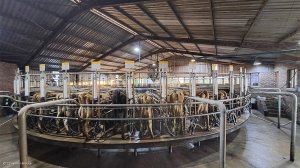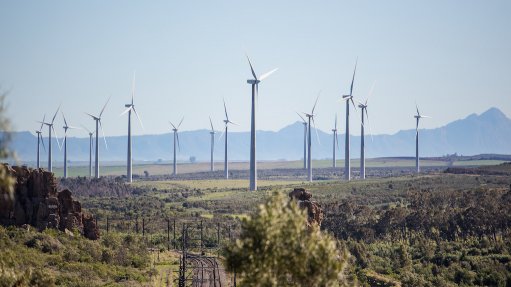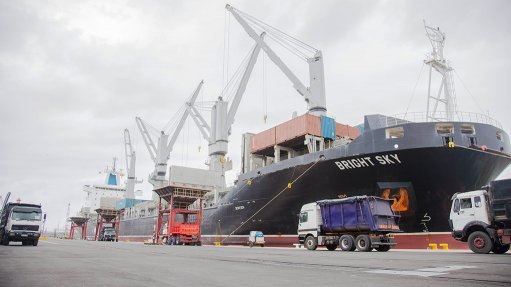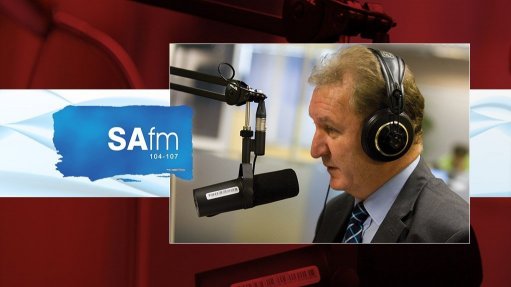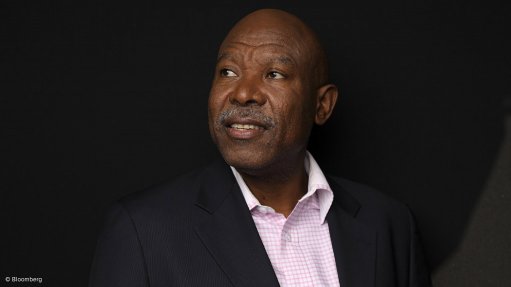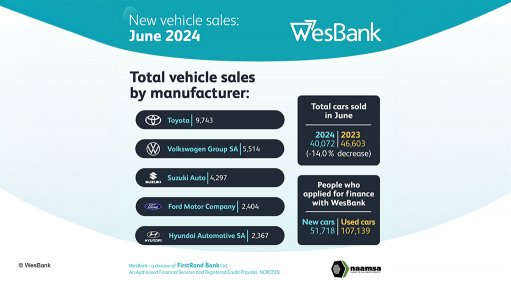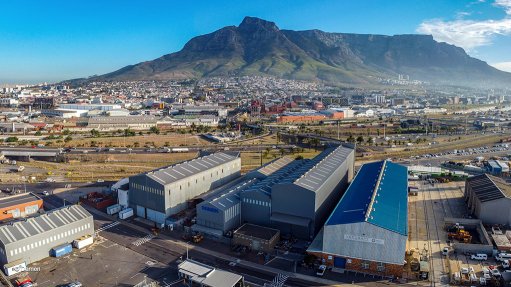Nestlé’s South African dairy farm, factory exemplifiers of group’s sustainability goals

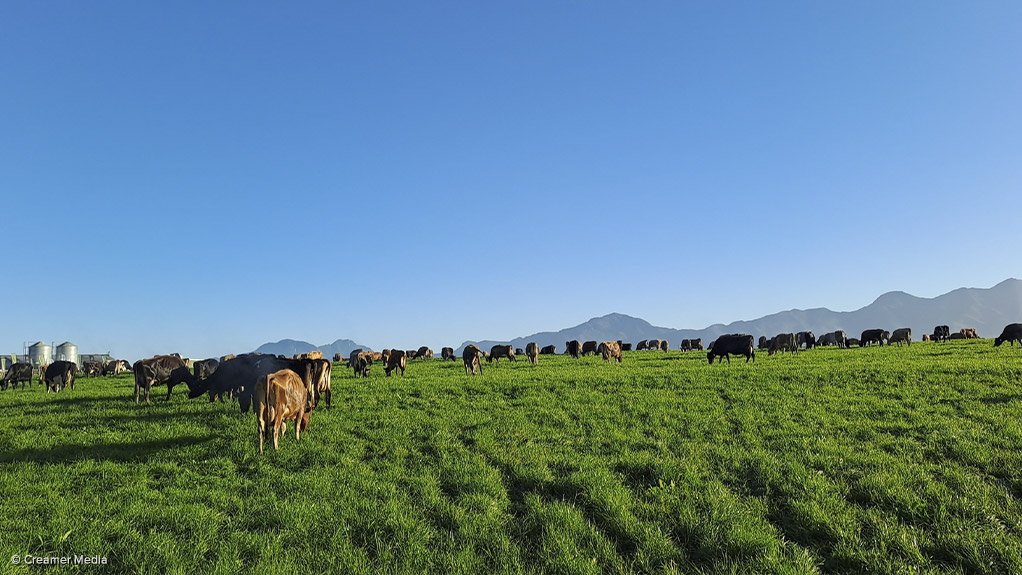

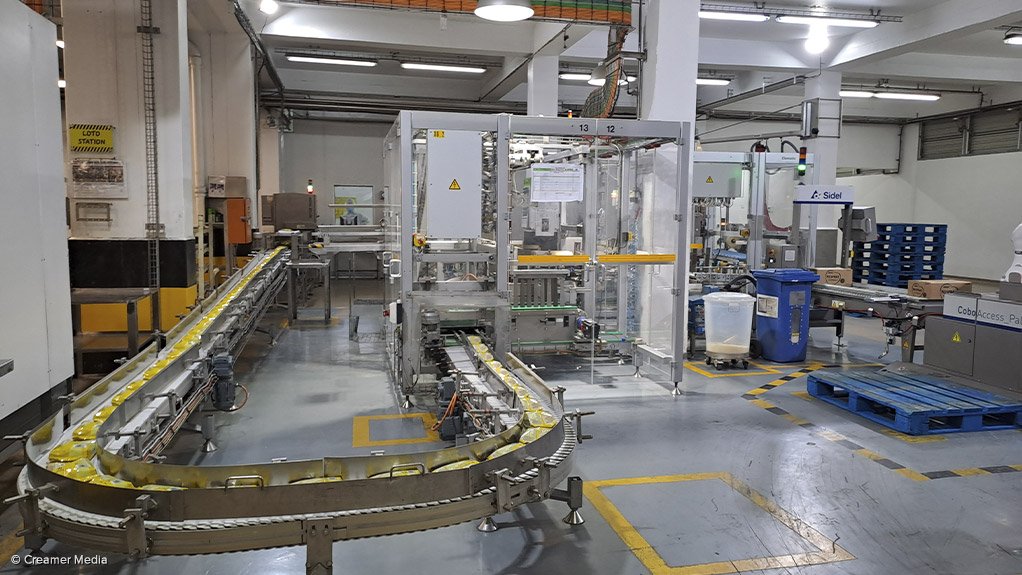
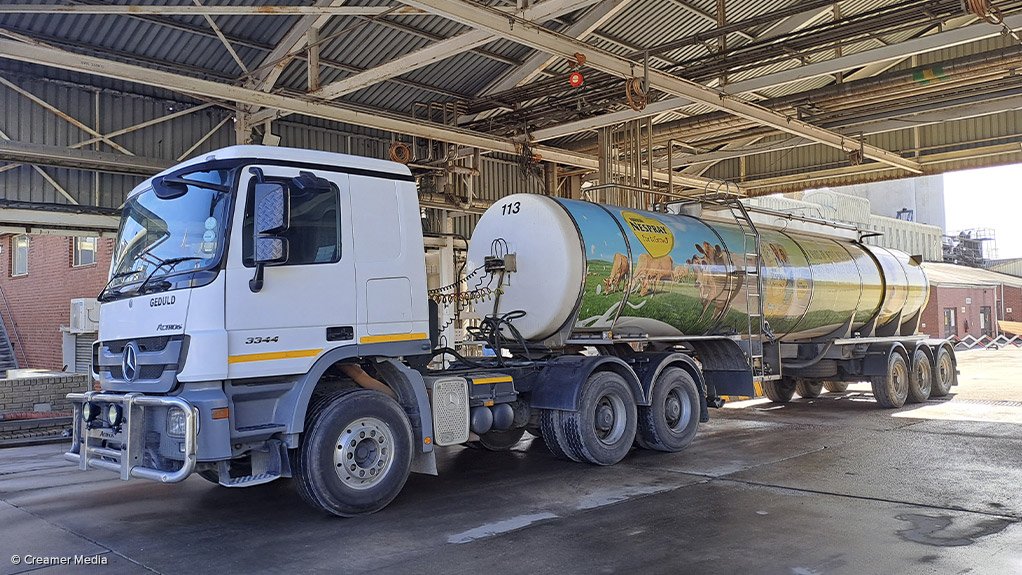
Skimmelkrans dairy farm
Photo by Creamer Media's Tasneem Bulbulia
Rotating milking and feeding system at Skimmelkrans
Photo by Creamer Media's Tasneem Bulbulia
Packaging at the Nestlé’s Mossel Bay dairy factory. Nestlé is aiming to have 100% recyclability for its sachets sourced locally by the end of this year
Photo by Creamer Media's Tasneem Bulbulia
Nestlé's tankers have been redesigned to be lighter for a lower carbon footprint. These are also washed using treated process water from its dairy factory
Photo by Creamer Media's Tasneem Bulbulia
As Swiss multinational food and drink processing conglomerate Nestlé’s seeks to reach its ambitious global target of waste-free operations and net-zero emissions by 2050, two of the group’s South African businesses – the Skimmelkrans dairy farm and the Mossel Bay dairy factory – stand as testament to the progress that it is making towards these goals.
The sustainability initiatives being undertaken at these operations were outlined during a site visit on June 20, intended to showcase the group’s “farm to glass journey” of dairy. It also formed part of Nestlé’s World Milk Day celebrations, which the group is undertaking this month in commemoration of this international day, which is observed on June 1.
The ‘Global Nitrous Oxide Budget 2024’ report, led by researchers from Boston College and published on June 12 in the journal Earth System Science Data, showed that emissions of nitrous oxide – a greenhouse-gas said to be more potent than CO2 or methane – continued unabated between 1980 and 2020, a year when more than ten-million metric tons were released into the atmosphere, primarily through farming practices.
Moreover, Nestlé East and Southern Africa Region (ESAR) Diary business executive officer Taku Mupfurutsa pointed out that 30% of the world’s emissions come from agriculture, with dairy farming responsible for 60% of this percentage.
“We have a big responsibility as the leaders in dairy to do tangible work to bring down emissions,” he emphasised.
Mupfurutsa explained that Nestlé’s “bold” 2050 target entails first halving emission by 2030, with this being a “journey”.
Nestlé’s approach entails reducing emissions, using measurable science-based interventions. “At Nestlé, we are moving – we can safely say, we have already left peak emissions behind.”
The group also strives for economic sustainability for its brands.
STARTING AT SOURCE
The Skimmelkrans dairy farm, located in George, in the Western Cape, is the group’s pilot project for low-carbon emissions, following the announcement in 2020 to pursue a net-zero project there. Nestlé has a longstanding partnership with the farm, procuring milk for its products.
A fourth-generation establishment, the family farm is run by farmer George Kuyler and his relatives. During a comprehensive tour of the farm, Kuyler highlighted that it now boasts 36 employees daily, throughout the year.
Mupfurutsa said the impact of this employment, when expanded, indirectly benefits about 360 people.
Skimmelkrans is one of the over 124 farms in the country from which Nestlé procures ingredients, which Mupfurutsa acclaimed showcases the expansive reach of this resource.
About two years ago, Nestlé started replicating the initiatives being undertaken at Skimmelkrans at other farms as well, where applicable, as well as driving other relevant interventions.
Skimmelkrans boats a pasture-based herd of over 1 000 cows. Adult female cows are artificially inseminated, with sperm procured globally. The farm leverages technology to ensure the best specimen is picked to ensure optimal pregnancy metrics. As with humans, cows only produce milk as a result of pregnancy.
Technology is also used to monitor the cows’ health throughout, to ensure optimum and safe production. Nestlé further uses this traceability when it receives the milk, to ensure uniformity of the product.
Milk production is seasonable, with the farm currently supplying about 13 000 litres daily. The cows are milked twice daily, using a rotating feeder and milking system. The system ensures that milk does not get touched by human hands, to prevent contamination.
INITIATIVES AT THE FARM
Nestlé’ ESAR Agricultural Services group manager Hoven Meyer emphasised that the farm pursues sustainability by focusing on protecting the environment and community and ensuring animal welfare at the farm.
It endeavours to implement regenerative agriculture systems. To ensure low-carbon products, emissions generated at the farms are displaced by removing the same amount from the atmosphere. This is done through myriad interventions including soil work, water conservation, feed management and manure processing.
For soil, the farm uses soil carbon sequestration, a process in which CO2 is removed from the atmosphere and stored in the soil carbon pool.
The soil at the farm is analysed yearly, with feedback used to create healthier soils.
Cows are responsible for considerable amounts of methane emissions, through belching from processing their feed, as well as from manure. Methane is one of the most harmful greenhouse gases emitted into the environment from cattle and dairy farming.
Meyer told Engineering News that Nestlé, in conjunction with academia, is currently experimenting with using feed that results in lower emissions. This involves trialling different feed components in a mix, and then measuring and analysing when cows exhale. This ongoing work is being undertaken at the farm and will be used to bolster work in lowering emissions.
Also, at Skimmelkrans, cow manure is collected while they graze, and then goes into a press that separates the solids from the liquids. The solids are released into the soil as compost, and the liquids into the pastures as irrigation, ensuring that less methane is released into the air.
For water, the farm undertakes water recycling; and uses soil water probes to irrigate at the optimum level.
The cows and farm are constantly monitored, and a computer programme ensures that food and fertiliser are optimised.
The farm also uses natural pesticides.
Skimmelkrans also has solar energy, and last year installed an ice bank. This allows for the cooling down of the milk to be done with considerably less energy, and using almost no fossil fuel sources.
From the cow’s body temperature of about 36 °C, milk has to be cooled down to about 3 °C to prevent contamination and for transport in tankers to Nestlé’s dairy factory.
The tankers have been redesigned to be lighter, thereby using less steel, and reducing the transportation carbon footprint. Moreover, drivers are encouraged to use less fuel on trips.
Nestlé also uses this as an opportunity to educate consumers, with branding and information displayed on the tankers, which shows the journey of milk from the farm to the final diary product.
The farm also has other biodiversity initiatives, including having about 32 beehives and several owl houses.
FACTORY SETTINGS
Milk obtained at Skimmelkrans is transported to Nestlé’s Mossel Bay dairy factory where it is used to produce Nestlé’s milk powder products of Nespray FortiGrow, Nido and Klim, and its liquid milk products of Gold Cross condensed milk, Ideal evaporated milk and Nestlé dessert and cooking cream.
As with the farm, the factory undertakes a variety of sustainability initiatives.
In 2017, the factory, which is located in a water-stressed region, invested in a water recovery system.
The factory processes fresh cow’s milk, which typically constitutes about 87% water, through an evaporation process. Using this system, evaporated water is captured and treated and used in various applications within the facility, eliminating the need for municipal water intake for these processes.
This reduces strain on the municipality, and also prevents the bulk of the water extracted from the milk from being wasted.
A further investment was made into a wastewater treatment plant, which treats process water from the factory for use in irrigation and the washing of trucks arriving from farms.
The factory is aiming to eventually reach water neutralisation, and these interventions are facilitating this.
Also, Nespray is a Proudly South African-branded product, with the factory being the sole place it is manufactured, and it now using locally-manufactured packaging solutions, in the vein of engendering eco-friendly production.
Moreover, Nestlé is aiming to have 100% recyclability for its sachets sourced locally by the end of this year.
The factory also capitalises on digital monitoring systems, which processes data and allows operators to make calculated decisions. Machines are also equipped with predictive maintenance systems.
The factory will continue to explore means of using AI to engender more sustainable manufacturing practices.
Comments
Press Office
Announcements
What's On
Subscribe to improve your user experience...
Option 1 (equivalent of R125 a month):
Receive a weekly copy of Creamer Media's Engineering News & Mining Weekly magazine
(print copy for those in South Africa and e-magazine for those outside of South Africa)
Receive daily email newsletters
Access to full search results
Access archive of magazine back copies
Access to Projects in Progress
Access to ONE Research Report of your choice in PDF format
Option 2 (equivalent of R375 a month):
All benefits from Option 1
PLUS
Access to Creamer Media's Research Channel Africa for ALL Research Reports, in PDF format, on various industrial and mining sectors
including Electricity; Water; Energy Transition; Hydrogen; Roads, Rail and Ports; Coal; Gold; Platinum; Battery Metals; etc.
Already a subscriber?
Forgotten your password?
Receive weekly copy of Creamer Media's Engineering News & Mining Weekly magazine (print copy for those in South Africa and e-magazine for those outside of South Africa)
➕
Recieve daily email newsletters
➕
Access to full search results
➕
Access archive of magazine back copies
➕
Access to Projects in Progress
➕
Access to ONE Research Report of your choice in PDF format
RESEARCH CHANNEL AFRICA
R4500 (equivalent of R375 a month)
SUBSCRIBEAll benefits from Option 1
➕
Access to Creamer Media's Research Channel Africa for ALL Research Reports on various industrial and mining sectors, in PDF format, including on:
Electricity
➕
Water
➕
Energy Transition
➕
Hydrogen
➕
Roads, Rail and Ports
➕
Coal
➕
Gold
➕
Platinum
➕
Battery Metals
➕
etc.
Receive all benefits from Option 1 or Option 2 delivered to numerous people at your company
➕
Multiple User names and Passwords for simultaneous log-ins
➕
Intranet integration access to all in your organisation



